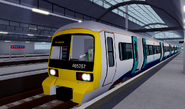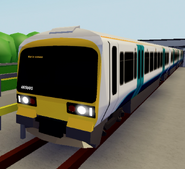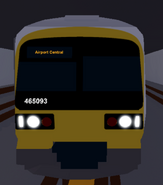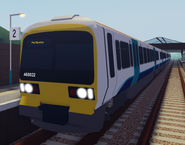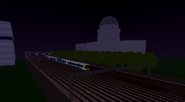(→Trivia) Tag: Visual edit |
(Let's keep it as Trivia - to keep it the same with the other pages) Tag: Visual edit |
||
| Line 21: | Line 21: | ||
The Class 465 ''[[:Category:Networker|Networker]] ''is an electric multiple-unit manufactured by BREL, ABB and Metro-Cammell, in use on [[Stepford Connect]]. These trains are formed of four coaches and costs 1125 points (1500 normally). |
The Class 465 ''[[:Category:Networker|Networker]] ''is an electric multiple-unit manufactured by BREL, ABB and Metro-Cammell, in use on [[Stepford Connect]]. These trains are formed of four coaches and costs 1125 points (1500 normally). |
||
| − | == Trivia |
+ | == Trivia == |
* The Class 465 is one of the slowest trains in all of Stepford County Railway, with a max speed of 75 MPH (alongside the [[Class 508]] and [[Class 458|Class 458/5]]). In addition, this train is the slowest 4-car train. |
* The Class 465 is one of the slowest trains in all of Stepford County Railway, with a max speed of 75 MPH (alongside the [[Class 508]] and [[Class 458|Class 458/5]]). In addition, this train is the slowest 4-car train. |
||
* These trains were rarely in use before the [[Next Generation]] upgrade, as the [[Previous Generation|Legacy]] version of this train was unfavorable among drivers due to their poor modelling and sounds. |
* These trains were rarely in use before the [[Next Generation]] upgrade, as the [[Previous Generation|Legacy]] version of this train was unfavorable among drivers due to their poor modelling and sounds. |
||
Revision as of 18:40, 8 June 2020
Template:Train
Overview

The Class 465 Networker is an electric multiple-unit manufactured by BREL, ABB and Metro-Cammell, in use on Stepford Connect. These trains are formed of four coaches and costs 1125 points (1500 normally).
Trivia
- The Class 465 is one of the slowest trains in all of Stepford County Railway, with a max speed of 75 MPH (alongside the Class 508 and Class 458/5). In addition, this train is the slowest 4-car train.
- These trains were rarely in use before the Next Generation upgrade, as the Legacy version of this train was unfavorable among drivers due to their poor modelling and sounds.
- This is the first Networker train in SCR.
- The train in-game seems to be based on BREL units in real-life, even though it has Metro-Cammell sounds - the distinctive Networker voice crack
- A form of longitudinal side seating is present in these trains, possibly the only seats of all trains in SCR that face sideways. This is located near the lavatory in coach (3 or 2)
- These are also single-seats, which may be the only single-seats that passengers can interact with, onboard a train.
- Due to the low top speed, not many people drive this train.
- These trains were upgraded to Next Generation in the Version 1.4.1 update.
- In real life, this train has 3+2 seating, not 2+2 like in the game. This is probably because of the amount of space in a carriage. The same applies to the 319, 321, 333, 350, 357, 360 and the 377.
- In real life, these trains are operated on only one operator: Southeastern. It is operated on the Metro services (out of Cannon Street, London-Hayes/Dartford, London-Orpington/Sevenoaks and London-Tunbridge Wells. They work on the same routes as the Class 376. Because of their use as a metro train, it is thought that this train was planned to be on Metro, and the community even went as far as to create a fake livery and put it on the original version of the train claiming it to be an official Metro livery. These theories have been debunked.
- This train will get a new livery in the upcoming patch update.
Known issues
- The door chimes are different in real life.
- The Passenger Information Screens (PIS) are in the wrong positions on this train. In real life, they are at every exit, not in the middle of the coach.
- The motor sounds of this train are broken (The starting sounds have improved over time, but the general motor sounds are still broken), this also results in less driver usage (Example: When a train is decelerating at a station for a stop, the train will still sound like it is accelerating, and when the driver fully slows down, it will play an odd, broken decelerating sound).
Gallery
Template:Network


